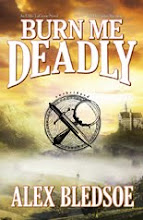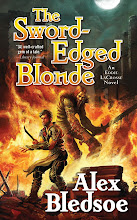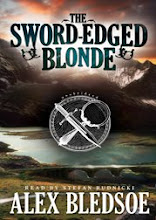Is there a more famous opening line in all literature than, "Call me Ishmael"? It introduces a mystery (the narrator doesn't say, "My name is Ishmael," he says you can
call him that), it sets up the tone, and it tells us that the narrator has a wry, dry wit. It's brilliant. So brilliant that even people who've never read
Moby Dick know it, and it's been used as both a joke (in the film version of
The League of Extraordinary Gentlemen) and a pick-up line (in the novel
Ahab's Wife).
I love Melville's book: I'm not a scholar, mind you, but a
fan. I've read all about the symbolism, what the whale represents in Melville's cosmology, and so forth, but
I love the book because it's an ass-kicking adventure with a monster and a strange, compelling protagonist. I even like the outdated chapters on whale biology, because it tells me what the book's characters knew about the beasts they hunted.
Stick with me through this next bit, because it all pulls together.

There's a subgenre of books that retell classic novels in simplified terms for young readers. Some are more obvious choices than others: you can read my interview with the author of a kid-friendly edition of
Dracula here. But Melville's classic, featuring as it does a genuine monster, an obsessed peg-legged maniac and loads of exciting seafaring action, is a favorite. We own several different versions.

Our go-to version is the
Great Illustrated Classics edition, "adapted" by Shirley Bogart. She retains the classic opening line. So does the
Dalmatian Press Children's Classic version, "condensed and adapted" by W.T. Robinson, which also includes a neat disclaimer/mission statement that says, in part, "...this is not the original version (which you really
must read when you're ready for every detail)." The
Treasury of Illustrated Classics version, "adapted" by Donna Carson, goes a bit askew, changing the line to "My name is Ishmael." That immediately jettisons Melville's ambiguity, which I know kids can understand because my five-year-old and I have discussed it.

But in the
Oxford Illustrated Classics edition, award-winning children's author
Geraldine McCaughrean adds two entire paragraphs before the famous line:
There is a whale in the sea, as white as a ghost, and it haunts me. It haunts me on winter nights, when the sky tumbles like a grey sea, when the sun overhead turns the grass sea-green, and the almond blossom rears up white over my head.
Sometimes, when I'm afloat in sleep, like a drowned sailor, he swims toward me--a nightmare all in white, jaws gaping, and I wake up screaming and salt-water wet with sweat. Somewhere out there in the bottomless ocean lives Moby Dick, a great white winter of a whale, and I shiver still at the thought of him. Even in summer.
Call me Ishmael.(p. 7)

When I read this, I thought: why did Ms. McCaughrean feel that one of the classic opening lines in literature needed a little more set up? So I asked her.
She responded, "Given the huge and leisured length of the original, I knew I had not only to get the story moving quickly but also state my intention on the first page - this is going to be a book about a whale, a really big, scary, menacing nightmare of a whale. Structurally, it's my promise to the reader - 'Look, even though you can't smell salt just yet, and I'm going to take a while introducing you to an assortment of oddballs, this is where we are heading - to an encounter with a damn great killer of a whale.'
"I also thought, given that this whale is at the centre of the book, the hub at the centre of the wheel, he ought to have 'first billing'. Naturally, I couldn't do without
the famous line, but I thought if anyone is going to step into the room first, it ought to be Moby."
So it seems she had a reason, and I appreciate her taking the time to explain it to me. And I can see her point, were this any other book. But I think she missed something crucial:
Moby Dick isn't a book about a whale, it's a book about a whale's effect on its human characters. Ishmael is our guide and proxy, leading us into the story not of a whale, but of a man (Ahab) whose sacriligious single-mindedness destroys everyone around him except Ishmael. And it may very well be that Ishmael's slightly aloof nature, the fact that he observes rather than fully participates in the madness around him, is what ultimately both saves him and lets him tell the story. He was "floating on the margin of the ensuing scene," as Melville puts it.
My point is, Ishmael earns his place at the story's introduction. And to begin any version of this story any other way is, in my opinion, to miss a whale-sized piece of the point.















































